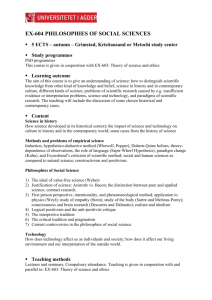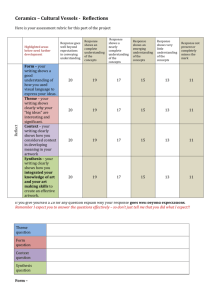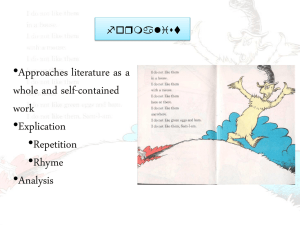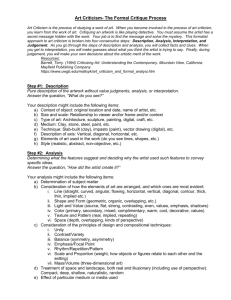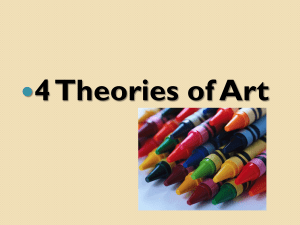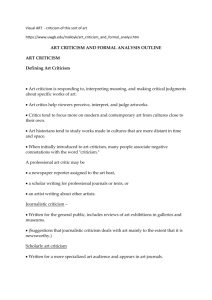Aesthetic Perception
advertisement
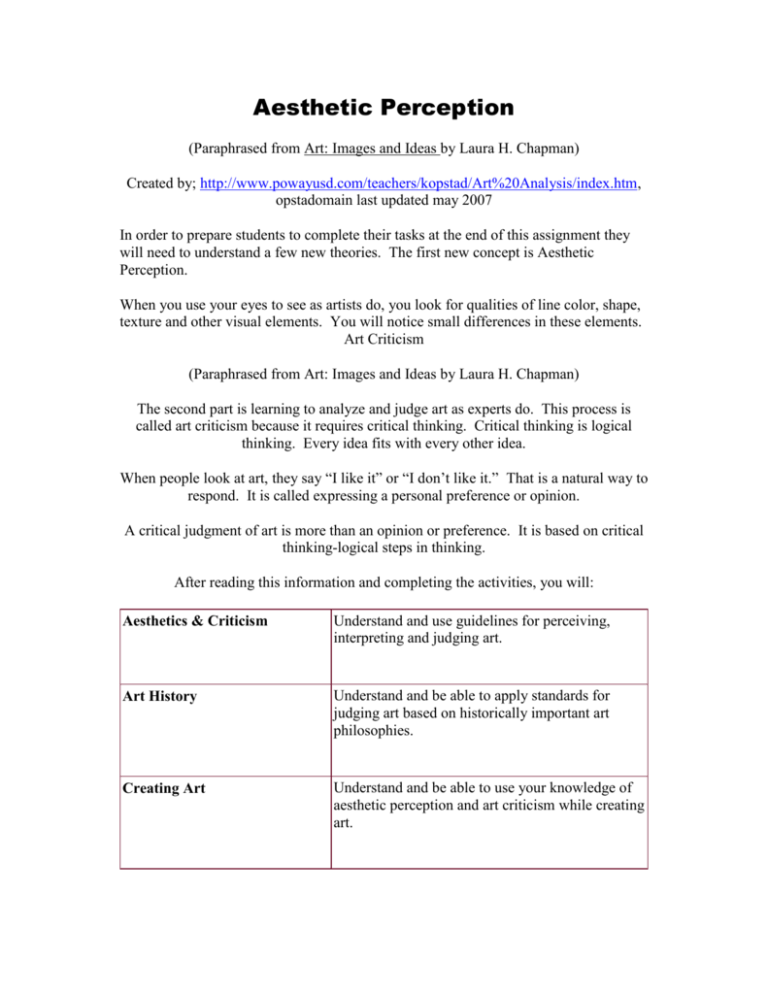
Aesthetic Perception (Paraphrased from Art: Images and Ideas by Laura H. Chapman) Created by; http://www.powayusd.com/teachers/kopstad/Art%20Analysis/index.htm, opstadomain last updated may 2007 In order to prepare students to complete their tasks at the end of this assignment they will need to understand a few new theories. The first new concept is Aesthetic Perception. When you use your eyes to see as artists do, you look for qualities of line color, shape, texture and other visual elements. You will notice small differences in these elements. Art Criticism (Paraphrased from Art: Images and Ideas by Laura H. Chapman) The second part is learning to analyze and judge art as experts do. This process is called art criticism because it requires critical thinking. Critical thinking is logical thinking. Every idea fits with every other idea. When people look at art, they say “I like it” or “I don’t like it.” That is a natural way to respond. It is called expressing a personal preference or opinion. A critical judgment of art is more than an opinion or preference. It is based on critical thinking-logical steps in thinking. After reading this information and completing the activities, you will: Aesthetics & Criticism Understand and use guidelines for perceiving, interpreting and judging art. Art History Understand and be able to apply standards for judging art based on historically important art philosophies. Creating Art Understand and be able to use your knowledge of aesthetic perception and art criticism while creating art. Criteria from Philosophies of Art (Paraphrased from Art: Images and Ideas by Laura H. Chapman) Art experts believe that you need to know criteria from philosophies of art to make sound judgments of art. A philosophy of art states how people should think about or judge it. Philosophers of art are called aestheticians. They study the history of ideas about art. Most aestheticians agree that there are four traditional philosophies of art and how to judge it: art as imitation, art as expression, art as formal order and art as instrumental. Click on each of the links below to learn more. Art as Imitation Art as Expression Art as Formal Order Art as Instrumental Art as Imitation (Paraphrased from Art: Images and Ideas by Laura H. Chapman) Some philosophies say that art is a way to imitate what you see. Accuracy and honesty in art are highly valued. A work of art might be judged good if it met many of the criteria listed below: First Impression: The work looks real. Design: The proportions of parts, colors and other elements seem natural and lifelike. The work is planned around pattern, rhythms and forms you see in nature or the human-made environment. Subject/Theme The subject or theme seems to be based on a real event or something the artist observed. The subject or theme is more realistic than abstract. It is honestly shown, not idealized. Materials You can see some of the natural qualities of the materials. The materials and techniques go with the mood rather than being the first things you notice. Functional or Decorative Art The use or function of the art can be seen in the form or design. (Form follows function.) Decorations are few or based on nature. Art as Expression (Paraphrased from Art: Images and Ideas by Laura H. Chapman) Some philosophies of art are based on respect for intense human feelings and originality. Standards for judging include: First Impression: The work expresses a definite feeling. Design: The proportion of parts, color, and other elements is unexpected or exaggerated. The total design is dramatic or original. It gives you a definite feeling. Subject/Theme: The subject or theme is unique, dream-like or fantastic. The subject or theme seems to come from the artist’s desire to communicate a strong feeling (the great joys, sorrows or problems of people). Materials: The use of materials is original or unexpected. The materials and techniques are an important part of the mood or feeling in the work. Functional or Decorative Art: The work has an unusual function or combines several functions. The design of the work is unexpected and causes you to react in new ways. Art as Formal Order (Paraphrased from Art: Images and Ideas by Laura H. Chapman) Some philosophies of art are based on respect for logical order and idealized forms people can invent. Standards for judging art include: First Impression: The work is beautiful, harmonious. Design: The work is unified by a kind of invented or mathematical order. The proportions of parts, colors and other elements are more perfect or idealized than you might see in life. The work is not filled with details you might see in life. Subject/Theme: The subject or theme is idealized or has a spiritual quality unlike everyday, ordinary life. The work is more abstract than realistic. Materials: You can see evidence of extreme care in using materials and finishing the work. You sense the artist knew exactly what to do with materials and techniques. Functional or Decorative Art: The form of the art is elegant, refined or dignified. The practical use of the object seems to be less important than the design. Art as Instrumental (Paraphrased from Art: Images and Ideas by Laura H. Chapman) Some philosophies of art emphasize the use of art in everyday life and for communication. Criteria for judging art are: First Impression: The work has an important message or function. Design: The proportions of colors and other elements are planned to help you understand the message of the work. The total design is useful. It is part of the message the artist wants you to understand. Subject/Theme: The subject or theme is related to the life of a cultural group. The subject or theme is important to almost all people at some time in their lives. Materials: The materials and techniques help you understands the message of the artwork. The materials and techniques are practical and related to the function of the artwork. Functional or Decorative Art: The work serves the purpose of communicating important ideas. The design or decoration is well suited for its purpose and isn’t too plain or fancy. Summary This lesson has contained a significant amount of information. Before we begin the assignments let’s summarize what you have learned so far. Evaluation Tools Vocabulary Web Resources Elements of Art Principles of Design What is Art? Aesthetic Perception Perceiving Subtle Qualities Imaginative Seeing Perceiving with More Than Your Eyes Art Criticism Aesthetics & Criticism Art History Creating Art Art Criticism (Continued) Step 1. Description: What do you see? Step 2. Analysis: How is the work planned? Step 3. Interpretation: What are the main expressive qualities? Step 4. Judgment: What are the strengths and weaknesses? Criteria from Philosophies of Art Art as Imitation Art as Expression Art as Formal Order Art as Instrumental Criteria from Philosophies in Art Art as Imitation Art as Expression Art as Formal Order Art as Instrumental Assignment #1 You are now going to apply what you have learned in this lesson. Click on the following link which will take you to a virtual art database. Select any painting that you connect with and analyze the artwork using your perception and analysis skills. Make sure to include the following: Include the title, artist, medium and date of the artwork. Base your critique on the four major steps in art criticism. A thorough critical description of the artwork using the art vocabulary, elements of art and principles of design. The art philosophy category this painting should be classified and explain why. The assignment needs to be typed and double spaced. There is no set length for how long your response should be, however you will not be able to successfully complete the assignment in less than five quality sentences. Assignment #2 Select one of your own artworks and critique it. Describe, analyze and interpret your artwork then you will judge it using the criteria that you think are appropriate to it. Include the title, artist, medium and date of the artwork. Base your critique on the four major steps in art criticism. A thorough critical description of the artwork using the art vocabulary, elements of art and principles of design. The art philosophy category this painting should be classified and explain why. The assignment needs to be typed and double spaced. There is no set length for how long your response should be, however you will not be able to successfully complete the assignment in less than five quality sentences. How to Critique Art Study Guide Name: 1. What are the main differences between the “Elements of Art” and the “Principles of Design”? 2. What is aesthetic perception? 3. Is aesthetic perception a skill that you are born with? Explain. 4. What is nonobjective art and how should it be critiqued? 5. What is art criticism? 6. What purpose does art criticism serve? 7. What are the four major steps in art criticism? List and summarize. 8. What are the four major criteria from philosophies of art? Which do you feel is most significant? 9. Which philosophy of art is categorized by the viewer’s first impression being beautiful and/or harmonious? 10. Should you only look at art with your eyes? Explain.

